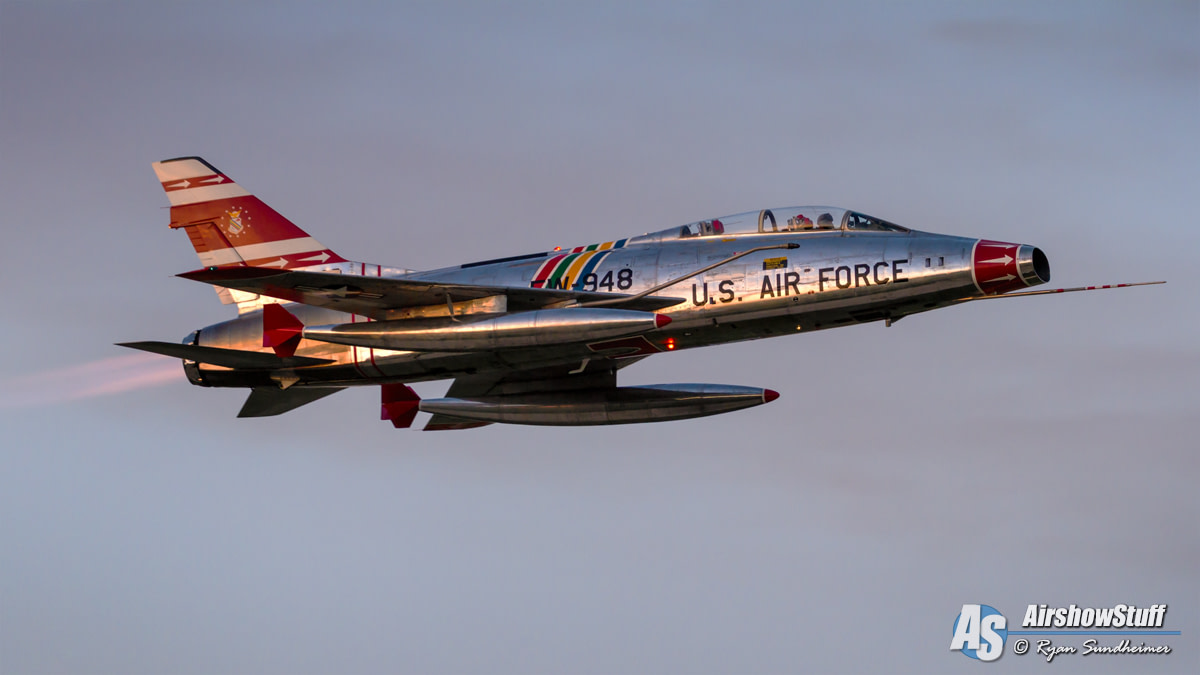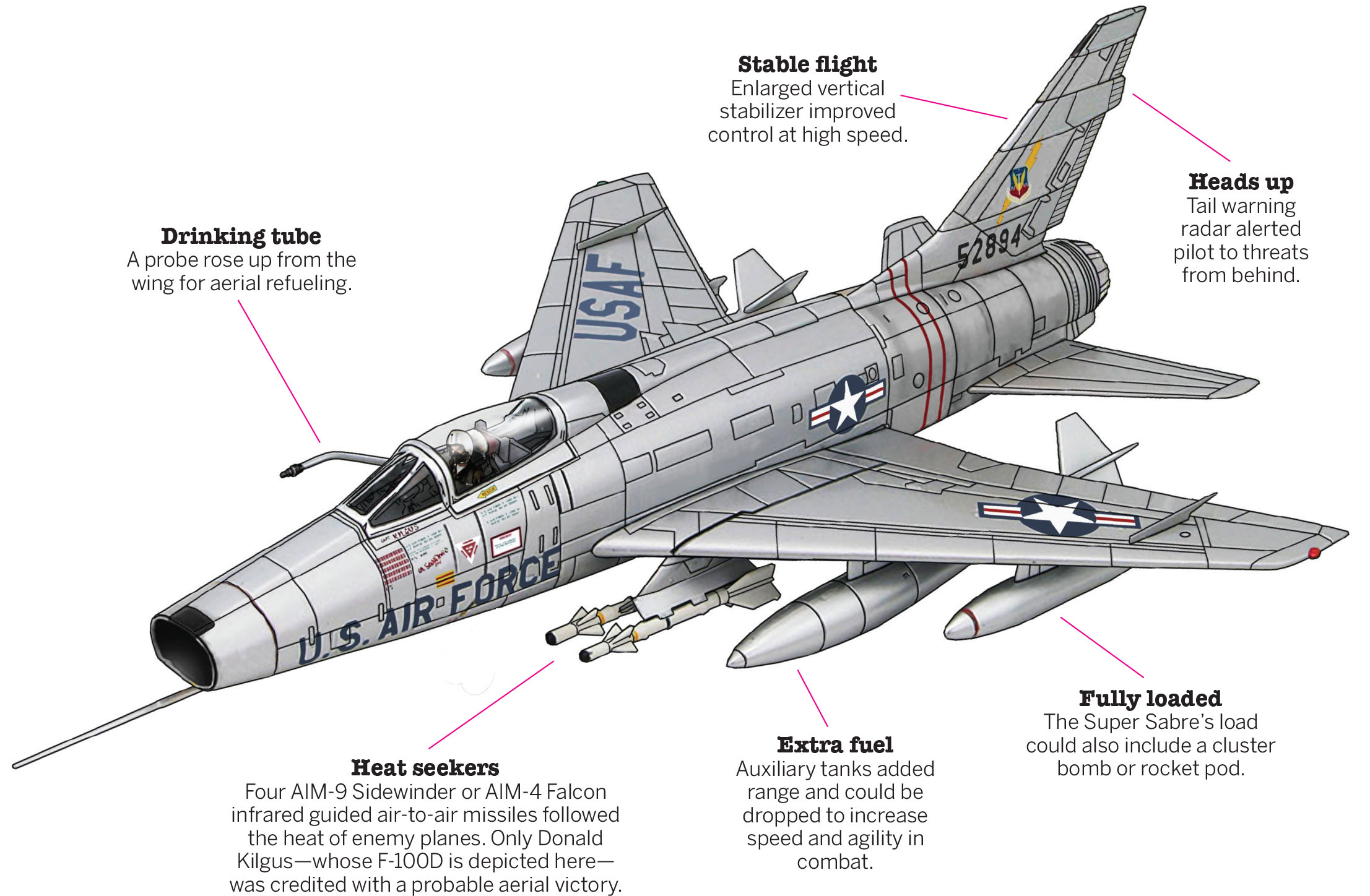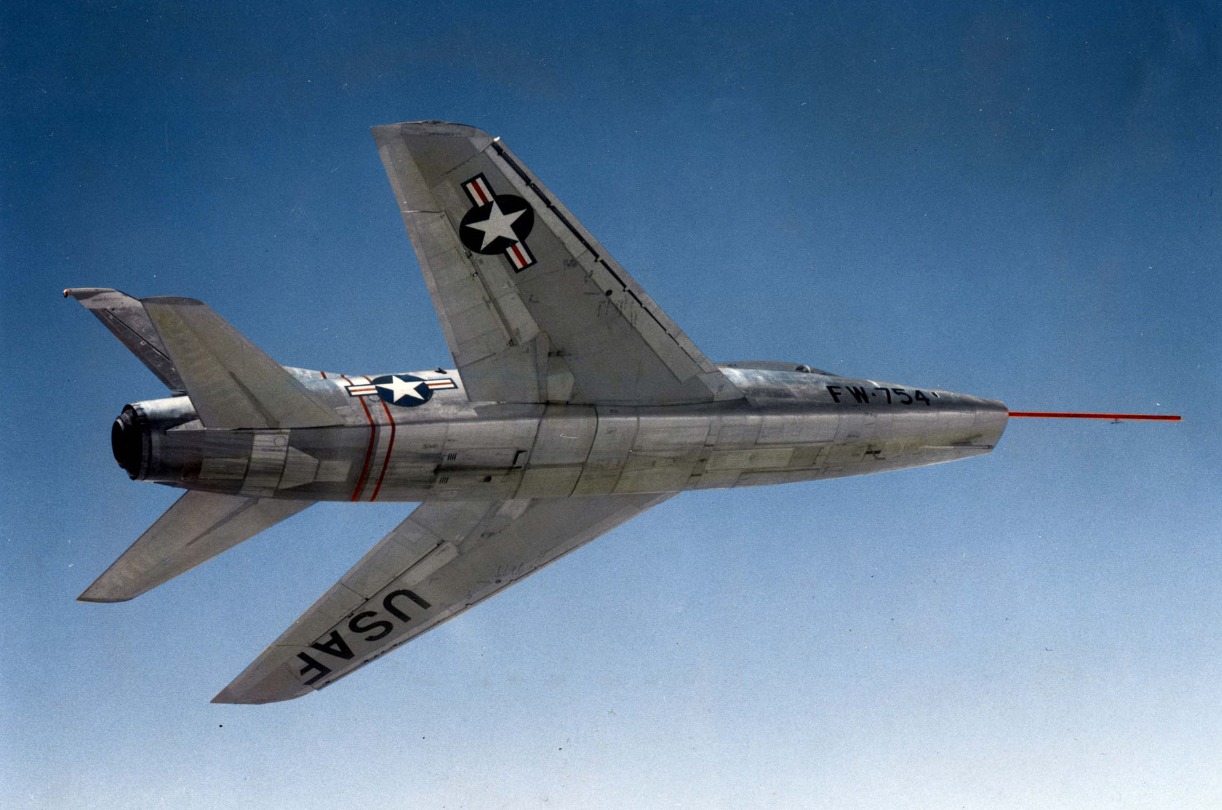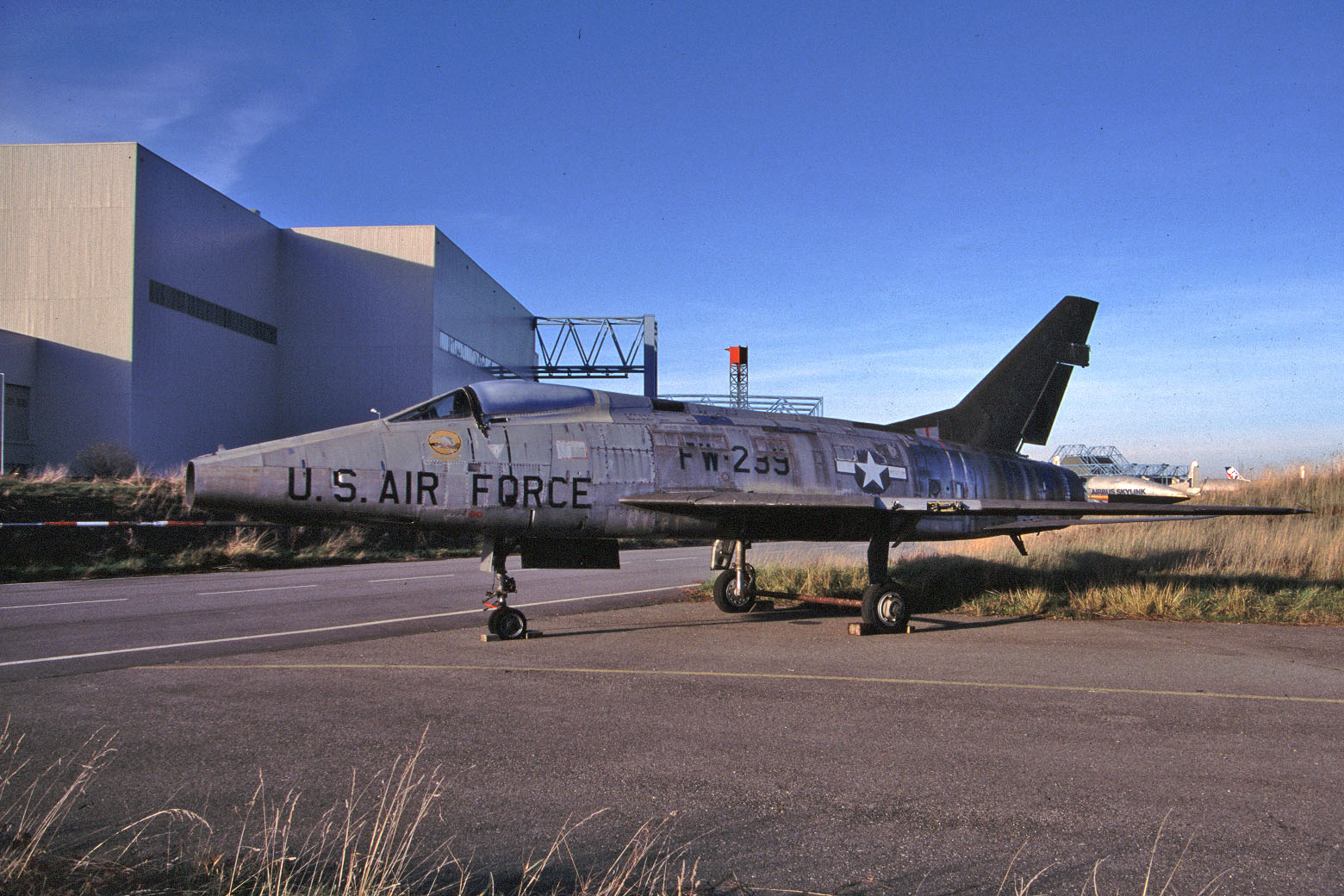F100 Super Saber - The North American F-100 Super Saber is a fighter jet developed by North American Aviation in the late 1940s.
It was the first successful attempt to build a fighter that could fly supersonic in horizontal flight. In May 1953, this device broke the sound barrier, and on October 29, 1953, the Super Saber set a world record when it reached 1,217 km/h. In 1954, the aircraft entered service with the US Air Force. For the factory, it was the successor to the F-86 Sabre.
F100 Super Saber

Despite successful flights, several early accidents led to the aircraft being ground-breaking in 1954 due to instability at high speeds; an effect called inertial coupling. This was only reversed after the manufacturer made modifications to the wingtips and increased the tailplane. The Super Saber was produced until May 1959. A total of 2,294 parts left the conveyor.
North American F 100 Super Sabre Blueprint
The US Air Force had the F-100 in heavy operational use from 1954 to 1971. It was continuously used for close air support missions during the Vietnam War. It was then replaced in the US Air Force by the Chance Vought A-7 Corsair.
The F-100 also flew in various NATO air forces. The aircraft served in the French Air Force until 1972, in the Danish Air Force until 1982, and in the Turkish Air Force until 1985. American aircraft stationed in Europe were located at the following airfields:
The F-100 Super Saber was also known as the Supsab and the Hun. Both are acronyms, namely Super Saber and One Hundred.
The aircraft in the photos is the F version, a two-seater training version. The C and D versions flew in Vietnam as fighter-bombers. They were stationed at the following airfields:
F 100 Super Sabre (3) By Macsix On Deviantart
The aircraft flew successively for the US Air Force, the French Air Force and again the US Air Force. On January 20, 1988, the aircraft was placed in storage on behalf of the United States Air Force Museum. Eight years later, the F-100D arrived in the Netherlands and was assigned the colors of the 32nd Fighter-Interceptor Squadron at Sosterberg from 1956-1960. The North American F-100 Super Saber is an American supersonic jet fighter that served in the United States Air Force (USAF) from 1954 to 1971 and in the Air National Guard (ANG) until 1979. The first Ctury series jet aircraft. fighters, it was the first fighter of the US Air Force capable of developing supersonic speed in horizontal flight.
The F-100 was developed by North American Aviation as a high-performance successor to the F-86 Saber air superiority fighter.
Adapted as a fighter-bomber, the F-100 was replaced by the high-speed Republic F-105 Thunderchief for strike missions in North Vietnam. The F-100 flew extensively over South Vietnam as the Air Force's primary close air support aircraft until it was replaced by the more efficient subsonic LTV A-7 Corsair II.

The F-100 also served in other NATO air forces and in other US air forces. allies. In later life he was often referred to as "Hun", a shortened version of "hundred".
F 100 D Super Sabre ..
In January 1951, North American Aviation submitted an unsolicited proposal to the US Air Force to create a supersonic day fighter. Named the Saber 45 due to its 45° wing sweep, it was an evolution of the F-86 Sabre. The layout was tested on July 7, 1951, and after more than 100 modifications, the new aircraft was accepted as the F-100 on November 30, 1951. The extensive use of titanium throughout the aircraft was prominent.
On January 3, 1952, the US Air Force ordered two prototypes, followed by 23 F-100As in February and another 250 F-100As in August.
The first flight of the YF-100A took place on May 25, 1953, seven months ahead of schedule. It reached Mach 1.04 on this first flight, despite being powered by the smaller XJ57-P-7 engine. The second prototype flew on 14 October 1953, followed by the first production F-100A on 9 October 1953. An operational evaluation by the US Air Force from November 1953 to December 1955 concluded that the new fighter was superior in performance, but stated that it is not ready for large scale. deployment due to several design flaws. These findings were later confirmed during the "Project Hot Rod" performance tests.
Six F-100s arrived at the Air Range Command (APGC) at Eglin Air Force Base in August 1954. The Air Force Operational Test Center (AFOTC) was scheduled to use four fighters in operational suitability testing, while the other two underwent weapons testing at the Air Force Weapons Center. The Tactical Aviation Division of the AFOTC conducted APGC testing under the direction of Lt. Col. Chris W. Brown's design office. Initial testing was completed by APGC personnel at Edwards AFB.
F 100 Super Sabre Of The National Military Museum (nl)
Of particular concern was yaw instability under certain flight conditions, which created inertial coupling. The aircraft could suddenly turn yaw and bank, which would happen too quickly for the pilot to correct, and would quickly overload the airframe until it collapsed. In these conditions, on October 12, 1954, North American Chief Test Pilot George Welch died during a test dive of an early production F-100A (serial number 52-5764).
Another control problem arose from the wing's sweep control characteristics at high angles of attack. As the aircraft approached stall speed, the loss of lift at the wingtips caused a severe pitch. This particular famon (which could easily prove fatal at low altitude with insufficient time to recover) became known as the "saber dance".
However, delays in the Republic F-84F Thunderstreak program resulted in the Tactical Airlift Command (TAC) fielding the crude F-100A. The TAC also requested that future F-100s be fighter-bombers capable of delivering nuclear bombs.

Unlike modern stabilizers that use an anti-servo, the springs were attached to the yoke to provide increased resistance to the pilot.
Meet The F 100 Super Sabre: America's First Supersonic Fighter
The North American F-107 was a further development of the Mach 2 F-100 with the air intake moved above and behind the cockpit. It was not produced in favor of the Republic F-105 Thunderchief.
The F-100A officially entered service with the US Air Force on September 27, 1954 as part of the 479th Fighter Wing at George AFB, California. On November 10, 1954, the F-100A suffered six serious accidents
Due to flight instability, structural failures, and hydraulic system failures, which led the USAF to retire the tire fleet by February 1955. The 479th finally entered service in September 1955. Due to ongoing problems with the USAF began phasing out the F -100A in 1958, with the last aircraft withdrawn from active service in 1961. By then, 47 aircraft had been lost to serious accidents.
Escalating tensions over the construction of the Berlin Wall in August 1961 forced the US Air Force to return the F-100A to combat service in early 1962. The aircraft was finally withdrawn from service in 1970.
F 100 Restoration; Tribute To Air National Guard Legacy > Air National Guard > Article Display
The TAC order for the fighter-bomber was processed with the F-100C flying in March 1954 and entering service on 14 July 1955 with the 450th Fighter Wing at Foster AFB, Texas. Operational tests in 1955 showed that the F-100C was at best an interim solution, sharing all the shortcomings of the F-100A. The improved J57-P-21 engine increased performance but still suffered from compressor failures, but the F-100C was considered an excellent platform for nuclear bombing because of its high top speed. The inertial linkage problem was cleverly solved by installing a yaw damper on the 146th F-100C, which was later retrofitted to earlier aircraft. A pitch damper was added starting with the 301st F-100C at a cost of $10,000 per aircraft.
The addition of "wet" mounting assemblies meant that the F-100C could carry a pair of 275 U.S. gallon (1040 L) and a pair of 200 U.S. gallon (770 L) licorice container. However, the combination caused a loss of stability at high speeds, so the four tanks were soon replaced by a pair of 450 U.S. gal (1730 l) licorice capacity. The 450 proved rare and wide, and was often replaced by smaller 335 US gal (1,290 L) tanks. Of greater concern to TAC was the fact that in 1965 only 125 F-100Cs were capable of using all non-nuclear weapons in the US Air Force inventory, particularly cluster bombs and AIM-9 Sidewinder air-to-air missiles.
When the F-100C was withdrawn from service in June 1970, 85 were lost to serious accidents.

The final F-100D was intended to address the offensive shortcomings of the F-100C, which was primarily an attack aircraft with additional fighter capabilities. To this end, the aircraft was equipped with an autopilot, upgraded avionics and, beginning with the 184th production aircraft, the AIM-9 Sidewinder. In 1959, 65 aircraft were modified to fire the AGM-12 Bullpup air-to-surface missile. To further address dangerous flying characteristics, the wingspan was increased by 26 inches (66 cm) and the vertical tail area increased by 27%.
North American F 100f Super Sabre > National Museum Of The United States Air Force™ > Display
The first F-100D (54–2121) flew on January 24, 1956, piloted by Daniel Darnell. Commissioned on 29 September 1956 at 405th Fighter Wing, Langley AFB. The aircraft suffered from reliability problems with the constant speed drive, which supplies constant frequency current to the electrical systems. In fact, the drive was so unreliable that the US Air Force required it to have its own oil system to minimize damage in the event of a failure. Landing gear and chute malfunctions killed several aircraft as well
Super saber vr, nendoroid saber super movable edition, dino super charge saber, super saber f100, f100 super sabre for sale, super saber lightsaber, f100 super nationals, f100 super sabre, power rangers super megaforce saber, super saber jet, dino super drive saber, f100 super sabre cockpit
0 Comments